Answer the following :
In Fig.6.13. (i) the man walks 2m carrying a mass of 15kg on his hands. In Fig. 6.13. (ii), he walks the same distance pulling the rope behind him. The rope goes over a pulley, and a mass of 15 kg hangs at its other end. In which case is the work done greater?
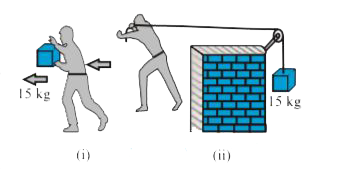 Solution in Bengali
Solution in Bengali
In the second case.
Topper's Solved these Questions
- WORK, ENERGY AND POWERBook:NCERT BANGLISHChapter:WORK, ENERGY AND POWERExercise:EXERCISES (ADDITIONAL EXERCISES)
Explore 6 Videos
- WORK, ENERGY AND POWERBook:NCERT BANGLISHChapter:WORK, ENERGY AND POWERExercise:EXERCISES (ADDITIONAL EXERCISES)
Explore 6 Videos
- WAVESBook:NCERT BANGLISHChapter:WAVESExercise:Exercises
Explore 26 Videos
Similar Questions
A bullet of mass 0.012kg and horizontal speed 70ms−1 strikes a block of wood of mass 0.4kg and instantly comes to rest with respect to the block. The block is suspended from the ceiling by means of thin wires. Calculate the height to which the block rises. Also, estimate the amount of heat produced in the block.
View SolutionA bullet of mass 0.012kg and horizontal speed 70ms−1 strikes a block of wood of mass 0.4kg and instantly comes to rest with respect to the block. The block is suspended from the ceiling by means of thin wires. Calculate the height to which the block rises. Also, estimate the amount of heat produced in the block.
View SolutionA string of mass 2.50kg is under a tension of 200N. The length of the stretched string is 20.0m. If the transverse jerk is struck at one end of the string, how long does the disturbance take to reach the other end?
View SolutionThe pulley arrangements of Figs. (a) and (b) are identical. The mass of the rope is negligible. In (a) the mass m is lifted up by attaching a mass 2m to the other end of the rope. In (b), m is lifted up by pulling the other end of the rope with a constant downward force F=2mg. The acceleration of m is the same in both cases

View SolutionA block of mass M is tied to one end of a massless rope. The other end of the rope is in the hands of a man of mass 2M as shown in Fig. The block and the man art resting on a rough wedge of mass M . The whole system is resting on a smooth horizontal surface. The man starts walking towards right while holding the rope in his hands. Pulley is massless and frictionless. Find the displacement of the wedge when the block meets the pulley. Assume wedge is sufficiently long so that man does not fall down.
View SolutionAnswer the following:
a) The casing of a rocket in flight burns up due to friction. At whose expense is the heat required for burning obtained? The rocket or the atmosphere?
b) Comets move around the sun in highly elliptical orbits. The gravitational force on the comet due to the sun is not normal to the comet's velocity in general. Yet the work done by the gravitatonal force over every complete orbit of the comet is zero. Why?
c) An artificial satellite orbiting the earth in very atmosphere loses its energy grdually due to dissipation against atmospheric resistance, howerver small. Why then does its speed increase progressively as it comes closer and closer tothe earth? d)In fig i) the man walks 2m carrying a mass of 15 kg on his hands. In Fig ii) he walks the same distance pulling the rope behind him. The rope goes over pulley, and a mass of 15 kg hangs at its other end. In which case is the work done greater?
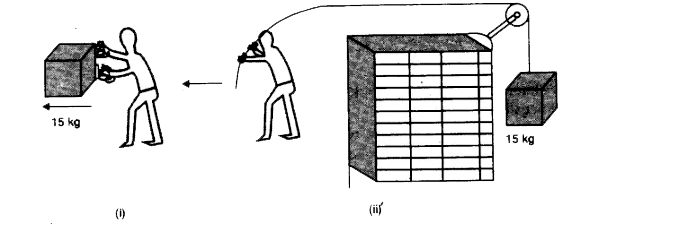
View SolutionA man of mass m stands on a frame of mass M. He pulls on a light rope, which passes over a pulley. The other end of the rope is attached to the frame. For the system to be in equilibrium, what force must the man exert on the rope?
View SolutionAnswer the following:
a) The casing of a rocket in flight burns up due to friction. At whose expense is the heat required for burning obtained? The rocket or the atmosphere?
b) Comets move around the sun in highly elliptical orbits. The gravitational force on the comet due to the sun is not normal to the comet's velocity in general. Yet the work done by the gravitatonal force over every complete orbit of the comet is zero. Why?
c) An artificial satellite orbiting the earth in very atmosphere loses its energy grdually due to dissipation against atmospheric resistance, howerver small. Why then does its speed increase progressively as it comes closer and closer tothe earth? d)In fig i) the man walks 2m carrying a mass of 15 kg on his hands. In Fig ii) he walks the same distance pulling the rope behind him. The rope goes over pulley, and a mass of 15 kg hangs at its other end. In which case is the work done greater?

View Solutionचित्र (a ) में एक व्यक्ति अपने हाथो में 15 किग्रा का कोई द्रव्यमान लेकर 2 मीटर चलता है। चित्र (b ) में वह उतनी ही दुरी अपने पीछे रस्सी को खींचते हुए चलता है। रस्सी घिरनी पर चढ़ी हुई है और उसके दूसरे सिरे पर 15 किग्रा का द्रव्यमान लटका हुए है। परिकलन कीजिए की किस स्थिति में किया गया कार्य अधिक है?
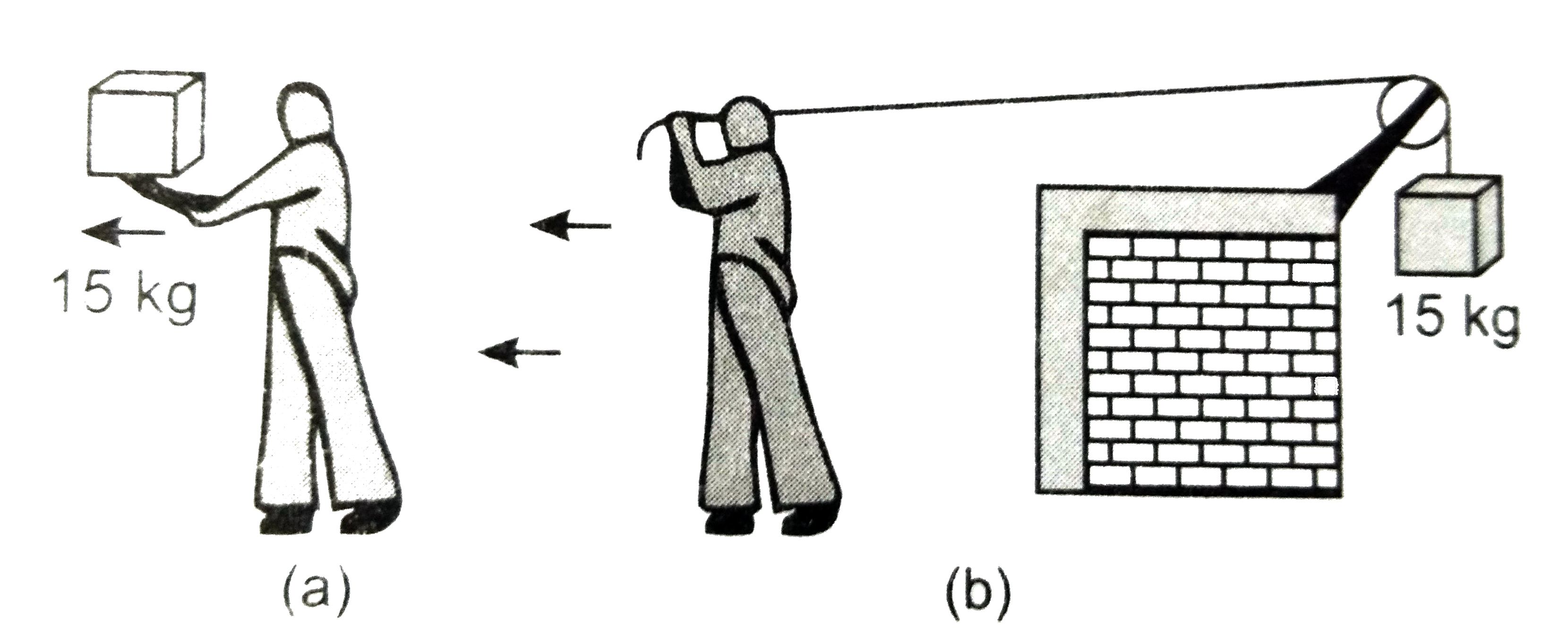
View Solutionनिम्नलिखित का उत्तर दीजिए -
चित्र ( i ) में एक व्यक्ति अपने हाथों में 15 kg का कोई द्रव्यमान लेकर 2m चलता है । चित्र ( ii ) में वह उतनी ही दूरी अपने पीछे रस्सी को खींचते हुए चलता है । रस्सी घिरनी पर चढ़ी हुई है और उसके दूसरे सिरे पर 15 kg का द्रव्यमान लटका हुआ है । परिकलन कीजिए कि किस स्थिति में किया गया कार्य अधिक है ?
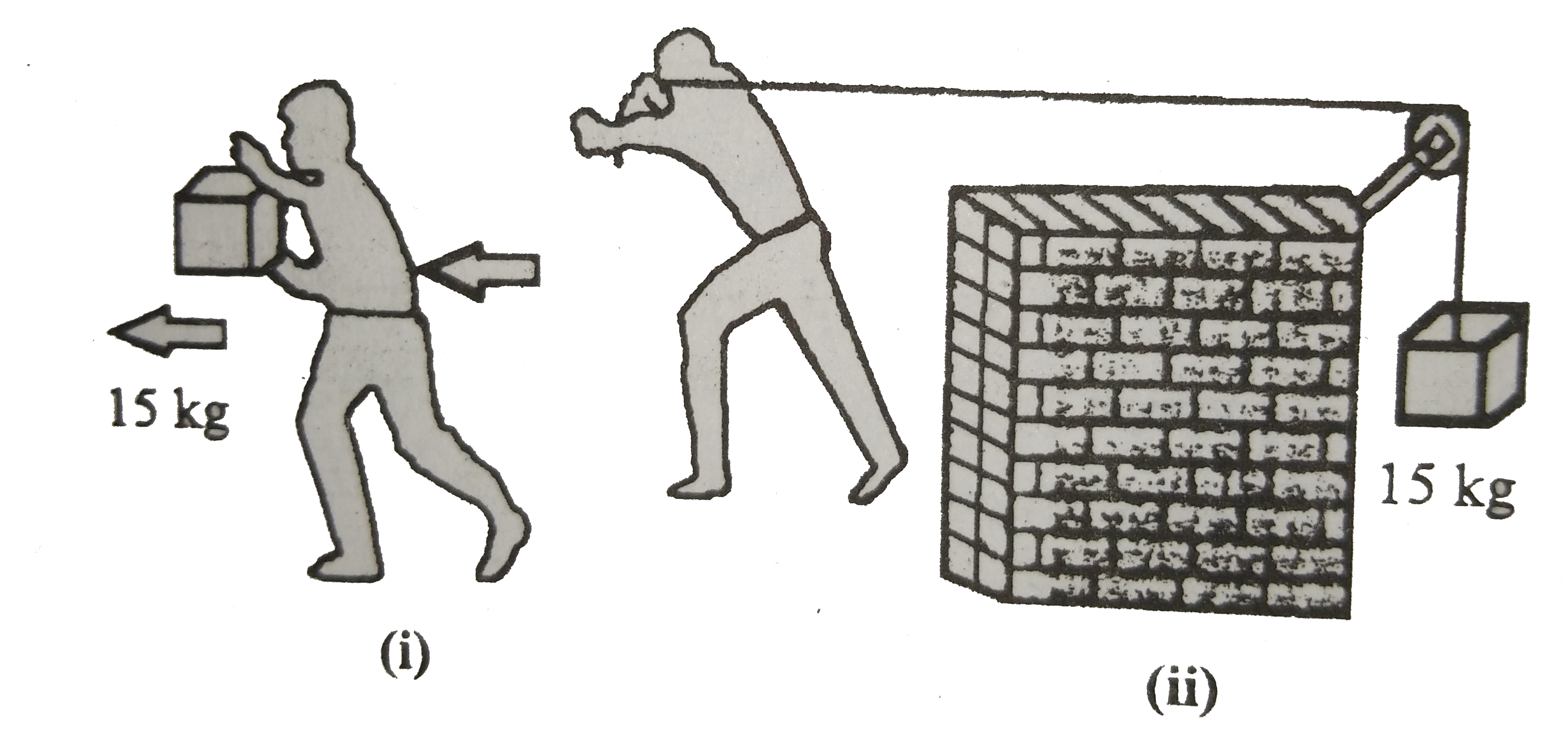
View Solutionवह उतनी ही दूरी अपने पीछे रस्सी को खींचते हुए चलता है | रस्सी घिरनी पर चढ़ी है और उसके दूसरे सिरे पर 15 kg का द्रव्यमान लटका हुआ है | दोनों स्थितियों में कार्य का परिकलन कीजिए | (g=10m/s2 लीजिये )
View SolutionAnswer the following : In Fig.6.13. (i) the man walks 2m carrying a mass of 15kg on his hands. In Fig. 6.13. (ii), he walks the same distance pulling the rope behind him. The rope goes over a pulley, and a mass of 15 kg hangs at its other end. In which case is the work done greater?
View SolutionAnswer the following :
In Fig.6.13. (i) the man walks 2m carrying a mass of 15kg on his hands. In Fig. 6.13. (ii), he walks the same distance pulling the rope behind him. The rope goes over a pulley, and a mass of 15 kg hangs at its other end. In which case is the work done greater?
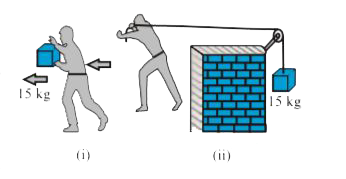
View SolutionThe pulley arrangements to Fig.(A) and (B), are identical. The mass of the rope is negligible. In (A) the mass mi s lifted up by attaching a mass 2m to the other end of the rope.
In (B) m is lifted up by pulling the other end of the rope with a constant downward force F=2mg. In which case the acceleration of 'm' is more?
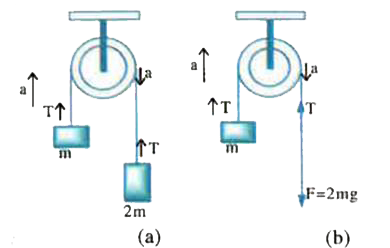
View SolutionIn figure (i) the man walks 2 m carrying a mass of 15 kg on his hands .In figure (ii) , he walks the same distance pulling the rope behind him . The rope goes over a pulley , and a mass of 15 kg hangs at its other end . In which case is the work done greater ?
View Solution

